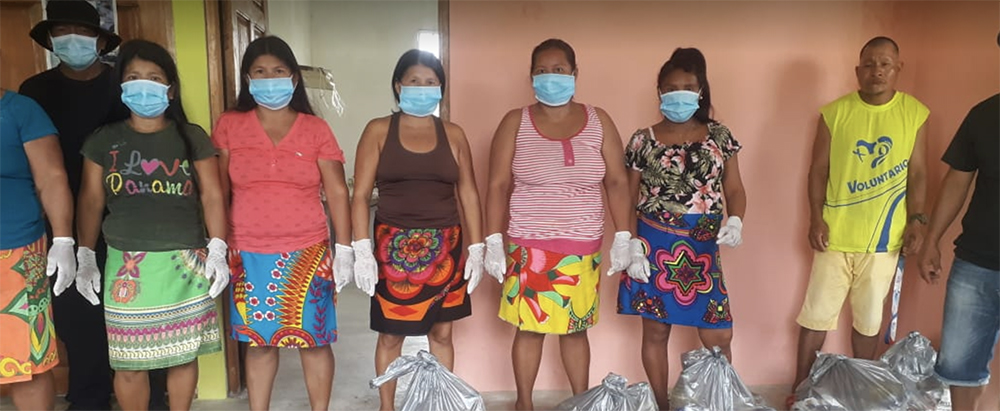When Elivardo Membache, leader of the indigenous Embera people in Panama, heard of the highly contagious virus going around—causing people, especially elders, to get very sick and even die—one of the first things he thought to do was to close down contact between his people’s villages and the rest of Panama. Many of the Embera villages in Panama are remote and difficult to access, requiring a long ride in a boat or a four-wheel drive vehicle. His village of Arimae, however, sits right off of the Pan-American highway. Barriers to entry would be needed to prevent the spread of the virus, so villagers set up a road block on the one dirt road coming into Arimae from the panamericana and took turns to staff the barricade. Their ability to shut off the road into their community, and to exclude outsiders, is based in large measure on the government’s official recognition of their indigenous collective land rights.
This story has been playing out across indigenous peoples’ communities in Panama and across the Amazon basin over the course of the pandemic. Land rights have been fundamental to the pandemic response of indigenous communities, as the legal recognition of their lands and sovereignty empowers them to exclude outsiders from their territories—often their first line of defense against the virus. Indigenous community mappers and forest monitors who have been trained and equipped in the context of lands rights and territorial defense are manning road blocks and river check points, acting as the eyes and ears of the community, and serving as a communication link back to larger regional and national federations. Erecting physical barriers on roads and rivers has long been a tactic of indigenous communities to resist outside incursions—one that has taken on new life and death meaning in the current context.
Despite the erection of community-instituted barriers and other safety measures, miners, loggers, traffickers, and other agents of illegal, extractive industries are trespassing and entering indigenous territories, sometimes violently. As the government’s eyes and efforts are turned elsewhere, the rule of law is poorly enforced. The lack of enforcement reveals the weakness of the system that is meant to protect and respect indigenous peoples’ rights, which in the current context multiplies their risk of exposure to COVID-19.
This has been especially true in Arimae, where illegal loggers are proliferating at the expense of the region’s resource rich, primary forests. Cacique Membache has documented cases in which communities have been subject to intrusions by illegal loggers, which corresponded to an uptick in virus cases despite the significant sacrifices those communities had made to keep themselves secluded and protected, even at great economic hardship. He has solicited government authorities to address the matter, but adequate and timely responses have been lacking. Indigenous territorial security is quickly becoming another casualty of the crisis in Panama.
Meanwhile, indigenous land rights are revitalizing strategies for community resilience in the face of the pandemic and national quarantines. Indigenous peoples’ deep knowledge of their lands and forests has granted them access to natural remedies and medicines to both prevent and cure diseases while promoting health and wellbeing. Given the poor access to Western medicines and high risks associated with conventional clinics during the pandemic, communities have had to rely more than ever on traditional medicines gathered from the fields and forests to treat regular, non-emergency conditions; assuage symptoms of illness; and naturally boost immune systems.
In many indigenous communities across Central and South America, there are growing efforts to systematize traditional medicinal knowledge, pass it on to the younger generations, and expand community cultivation of medicinal plants as part of efforts to strengthen food security. As a result, camps have been built in the forest to teach youth how to fully live off the land and efforts have been launched to establish more formal training institutes, botanical gardens and village production of ancestral remedies and cures. In Arimae, the community has been engaged in an exchange of preventative and curative medical recipes with neighboring communities. The people of Arimae benefit from the expanded knowledge and use of local medicinal herbs to stay home to treat regular ailments or to give birth, transferring only to the Western clinics in extreme cases. Furthermore, it is anticipated that renewed practices in traditional, ancestral medicines will continue to enrich and serve the communities well beyond the pandemic.
Communities’ success in keeping outsiders out of their territories ultimately corresponds to whether the recognition of their land rights is legally enforceable, and indeed, how well it is enforced in practice. The COVID-19 pandemic has put a finer point on the need for adequate enforcement. The Embera of Panama have fought long and hard to secure these rights, but the security they lack from inadequate enforcement puts their survival at risk. Although the end to the pandemic is far on the horizon, Cacique Membache and the people of Arimae withstand the brunt of the crisis because of their strength as a community to defend their territories and strengthen their resilience as their ancestors taught them.


